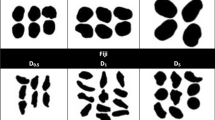Abstract
In zones washed by rain (façades, pinnacles, pilasters), fine siliceous sandstones are covered by a black varnish, which gives a dirty appearance to monuments. In composition, structure and areas covered by it, it differs from the usual black gypsum crust. Experiments carried out on blocks covered by black varnish show the modifications due to their growth. Results show that despite their low thickness and the coherence of the stone below, the accumulation of hydrophobic matters and the wetting-drying cycles modify the transfer properties of sandstones several centimeters below the surface. Thus, although sandstones seem to be protected by the black varnish, in the long run, a flake detachment process, in the areas covered by it, affects them. Therefore, damage to sandstones by black varnish can be explained by the fact that a wetting and drying cycle modifies the pore network.












Similar content being viewed by others
References
Acheson DT (1963) Vapor pressure of saturated aqueous salt solutions. In: Humidity and moisture, vol. 3. Rheinhold, New York, 521–530
Bousquie P (1979) Texture et porosité de roches calacaires. PhD Thesis, University Paris VI and Ecole des Mines de Paris, 191 pp
Dorn RI, Oberlander TM (1981) Microbial origin of desert varnish. Science 213:1245–1247
Dorn RI (1998) Rock coatings. Dev Earth Surface Proc 6:417
Engel CG, Sharp RP (1958) Chemical data on desert varnish. Bull Geol Soc Am 69:487–518
Everett DH (1961) The thermodynamics of frost damage to porous solids. Trans Faraday Soc 57:1541–51
Felix C, Maravelaki P (1992) Black crusts with different origines on limestones and sandstones. Proceedings 3d Int Colloquium on Materials Science and Restoration, Esslingen (Germany), F.H. Wittmann (ed), Expert Verlag 3:1728–1740
Fripiat J, Chaussidon J, Jelli A (1971) Chimie-physique des phénomènes de surface, applications aux oxydes et aux silicates. Masson & Cie, pp 16–52
Jeannette D (1979) Les pellicules d’altération des grès. 3 ème Congrès Internationnal sur la Détérioration et la Préservation de la Pierre, Venise, pp 65–80
Jeannette D (1981) Modifications superficielles de grès en oeuvre dans des monuments alsaciens. Sci Géol Bull 34(1)37–46
Jeannette D (1982) Les grès de la cathédrale de Strasbourg: leurs carrières d’origine. Bull Cath Strasb XV, pp 39–41
Konhauser KO, Ferris FG (1996) Diversity of iron and silica precipitation by microbial mats in hydrothermal waters, Iceland: implications for Precambrian iron formations. Geology 24:323–326
Machill S, Althaus K, Krumbein WE, Steger WE (1997) Identification of organic compounds extracted from black weathered surfaces of Saxonean sandstones, correlation with atmospheric input and rock inhabiting microflora. Org Geochem 27(1–2)79–97
Mertz J-D (1991) Structures de porosité et propriétés de transport dans les gres. Sciences géologiques, 90, PhD Thesis, University Louis Pasteur, Strasbourg
Nakae H, Inui R, Hirata Y, Saito H (1997) Effects of surface roughness on wettability. Acta Mater 46(7)2313–2318
NF B 10–502 (1980) Pierres calcaires: measures de l’absorption d’eau par capillarite. AFNOR
Nord AG, Ericsson T (1993) Chemical analysis of thin black layers on building stone. Stud Conserv 38:25–35
Rousset Tournier B (2001) Transferts par capillarité et évaporation dans des roches : rôles des structures poreuses. PhD Thesis, University Louis Pasteur, Strasbourg, 204 pp
Scheidegger A, Borkovec M, Sticher H (1993) Coating of silica sand with goethite: préparation and analytical identification. Geoderma 58:43–65
Schlünder EU (1963) A simple procedure for measurement of vapor pressure over aqueous salt solutions. Humidity and moisture, Rheinhold, New York, vol. 3, pp 535–544
Thomachot C (1998) Caractérisation pétrophysique des Tuffeaux de Chambord: étude de leur alteration. Master, University of Marne-la-Vallée, University of Strasbourg I, Inédit, 94 pp
Thomachot C, Jeannette D (2000) Petrophysical properties modifications of Strasbourg’s Cathedral sandstone by black crusts. 9 ème Congrès International sur la Dégradation et la Conservation des Pierres, Venise, pp 551–560
Urrutia MM, Beveridge TJ (1994) Formation of fine-grained metal and silicate precipitates on a bacterial surface (Bacillus subtilis). Chem Geol 116(1994):261–280
Zehnder K (1982) Verwitterung von Molassesandteinen an Bauwerken und in Naturaufschlüssen. Matériaux pour la géologie de la Suisse, Commission Géotechnique Suisse, 61, 130
Acknowledgements
This is EOST Contribution No. 2004.302-UMR7517.
Author information
Authors and Affiliations
Corresponding author
Rights and permissions
About this article
Cite this article
Thomachot, C., Jeannette, D. Effects of iron black varnish on petrophysical properties of building sandstone. Env Geol 47, 119–131 (2004). https://doi.org/10.1007/s00254-004-1139-4
Received:
Accepted:
Published:
Issue Date:
DOI: https://doi.org/10.1007/s00254-004-1139-4




